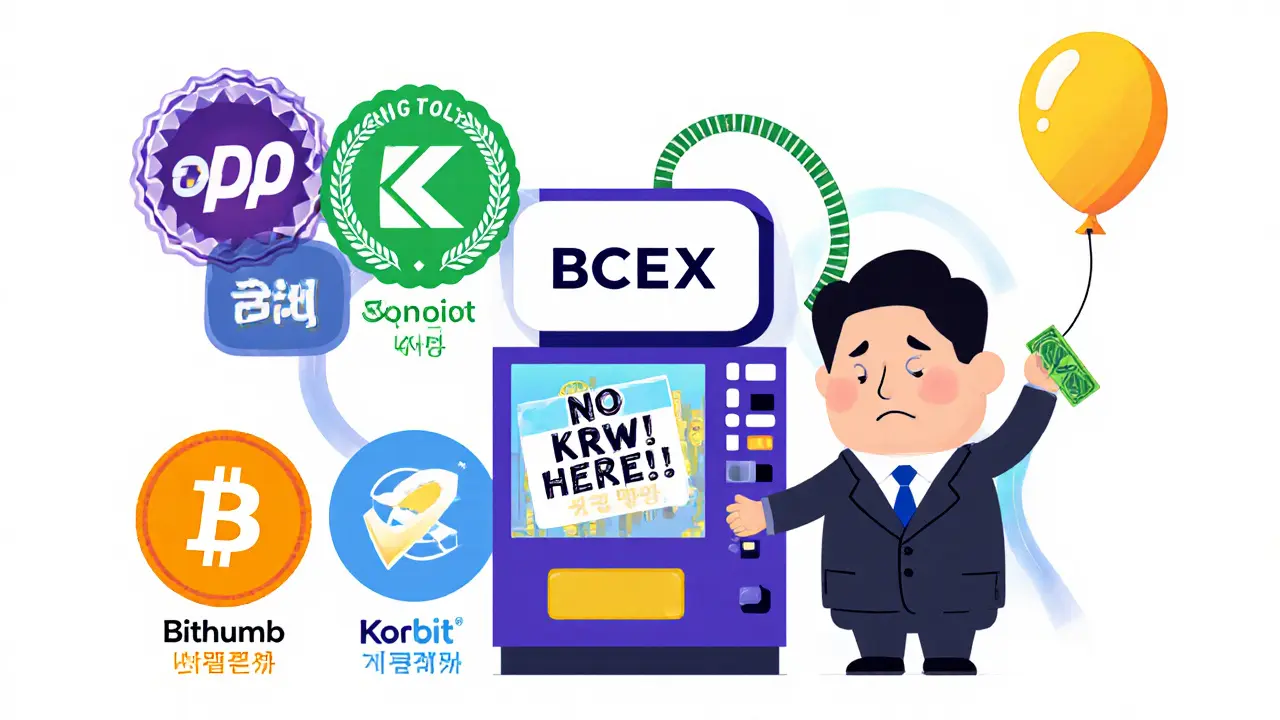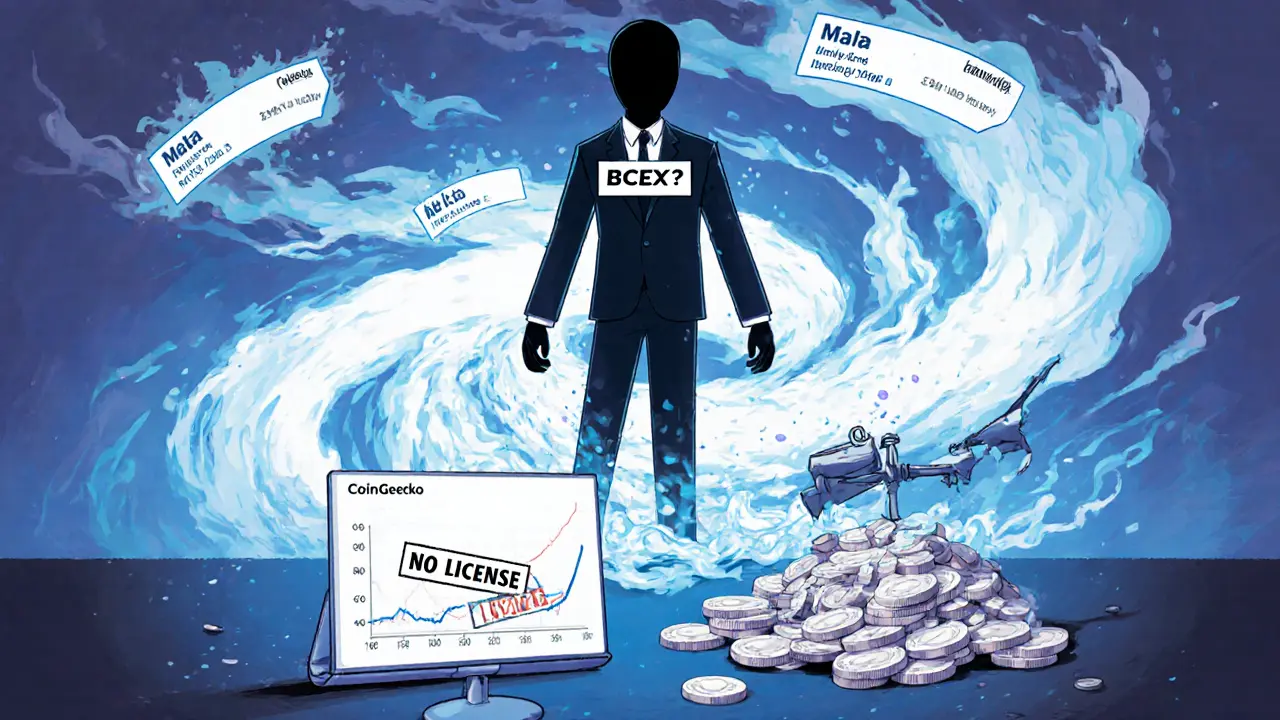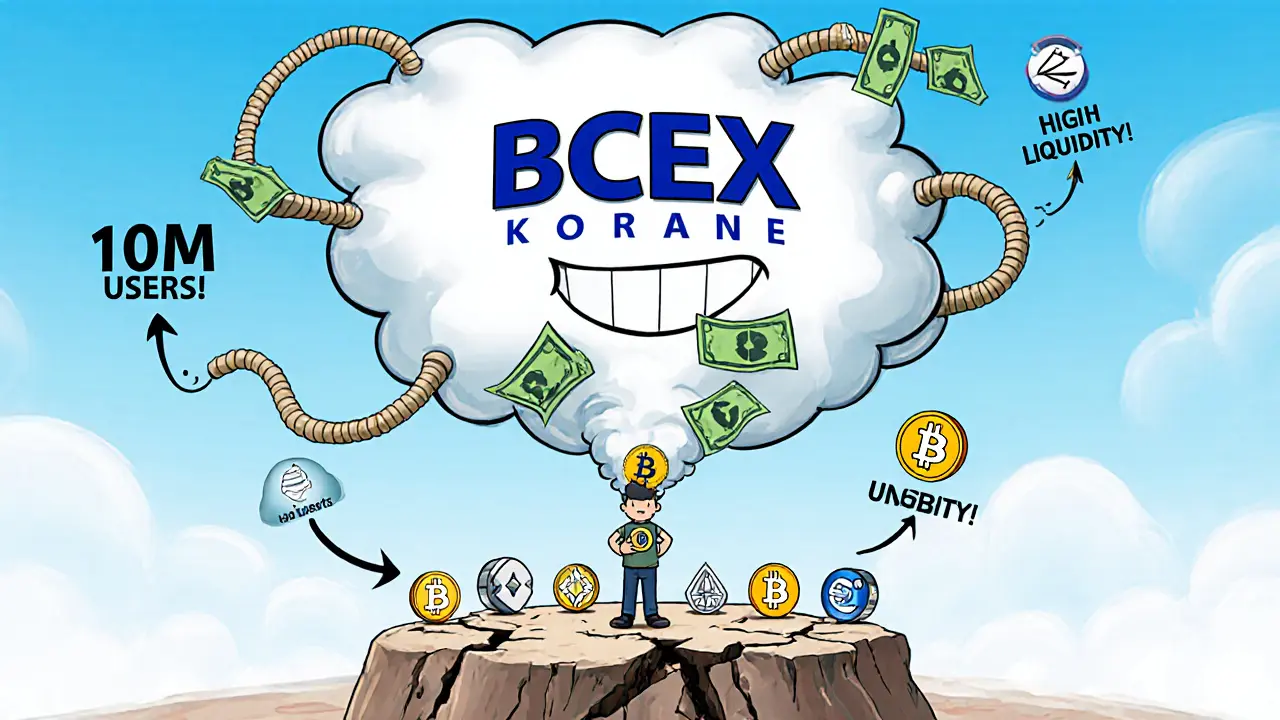BCEX Trading Volume Checker
Volume Discrepancy Calculator
BCEX claims to process $12 billion in daily volume. According to CoinGecko, it actually handles less than $3 million.
What This Means
BCEX claims $12B daily volume, but actual volume is less than $3M. That's a 4,000% discrepancy.
This gap suggests either misleading marketing or potential wash trading. Real exchanges don't hide their data from independent trackers.
Comparison: Upbit (Korean exchange) shows over $200 million in BTC/USDT liquidity. BCEX shows less than $500,000.
A $10,000 buy order on BCEX can move prices 2-3% (slippage). On Upbit, the same order would have minimal impact.
Result
Enter your estimated volume and click Calculate to see the discrepancy.
When you hear "BCEX Korea," you might picture a big, bustling crypto hub with hundreds of coins, deep liquidity, and thousands of traders lining up to make moves. But what you see on the website doesn’t match what’s happening on the trading floor. BCEX claims to be a global giant with over 10 million users and $12 billion in daily volume. The reality? On CoinGecko, it’s trading under $3 million a day with just seven active pairs. That’s not a typo. That’s a 4,000% gap between marketing and reality.
What BCEX Actually Offers Right Now
BCEX says it supports 500+ cryptocurrencies. If you log in today, you’ll find only seven coins available for trading: BTC, ETH, BNB, USDT, LTC, XRP, and DOT. That’s it. No Solana. No Cardano. No Shiba Inu. Not even a single Korean stablecoin, even though South Korea is actively exploring won-pegged tokens. The exchange lists seven trading pairs - all of them paired with USDT. No KRW deposits. No bank transfers from Korean accounts. If you’re in Korea and expecting to trade with won, you’re out of luck.Trading tools are basic: spot, margin, and futures are all listed as options. But margin trading requires a minimum of $1,000 in collateral, and futures contracts are limited to just two expiration cycles. The interface looks clean, but it’s not built for serious traders. No advanced charting tools. No API access for bots. No paper trading mode. It’s a stripped-down version of what you’d find on Binance or Upbit.
Where Is BCEX Even Based?
This is where things get messy. BCEX claims to be headquartered in Malta. Then it says Hong Kong. Then it mentions South Korea. No official registration documents are publicly available. No license number. No physical address you can verify. That’s not just sloppy - it’s a red flag.South Korea has strict rules for crypto exchanges. They must register with the Financial Services Commission (FSC), pass cybersecurity audits, and partner with a local bank. Upbit, Bithumb, and Korbit all do. BCEX doesn’t. There’s no record of BCEX being licensed by the FSC. That means if you deposit funds, there’s no legal protection. If the platform vanishes, you have no recourse. Not even the Korean government can help you.
Trading Fees and Liquidity - The Real Numbers
BCEX advertises “low fees” and “high liquidity.” Let’s check the numbers. Maker fees are 0.1%, taker fees are 0.2%. That’s competitive - on paper. But liquidity is where it falls apart. The order book for BTC/USDT shows bids and asks totaling less than $500,000. Compare that to Upbit, where the same pair has over $200 million in depth. On BCEX, a $10,000 buy order can move the price 2-3%. That’s slippage. That’s risk. That’s not trading - that’s gambling.There’s no evidence of market makers actively supporting the order books. No institutional volume. No hedge fund activity. Just retail traders chasing small pumps. The 26% daily volume change? That’s not growth. That’s one whale dumping 500 BTC and the price crashing. Then another one buying back. It’s not liquidity - it’s volatility masquerading as activity.

Why the Billion Claim Doesn’t Add Up
BCEX’s website says it handles $12 billion daily. CoinGecko says $3 million. Which one is real? Let’s break it down.First, $12 billion per day would make BCEX the 5th largest exchange in the world - bigger than Kraken, bigger than KuCoin. But BCEX doesn’t appear in the top 100 on CoinMarketCap’s volume rankings. It doesn’t show up in Chainalysis reports. No major wallet addresses are moving billions through BCEX. If it were true, every crypto news outlet would be covering it. They’re not.
Second, the 10 million users claim? No verification. No KYC stats. No user growth charts. No app store downloads. Google Trends shows zero search interest in BCEX in South Korea over the last six months. Meanwhile, Upbit gets over 2 million searches per month. If BCEX had 10 million users, even 1% of them would be enough to push its volume into the top 20. It’s not happening.
It’s likely BCEX is inflating numbers by counting every account ever created - even inactive ones. Or worse, using fake volume from wash trading. That’s common in smaller exchanges. But it’s not sustainable. And it’s not trustworthy.
Can You Use BCEX If You’re in the U.S.?
No. BCEX blocks U.S. IP addresses. If you try to sign up from the U.S., you’ll get a message saying “Service not available in your region.” That’s not a bug - it’s a legal safeguard. If BCEX were properly regulated, it wouldn’t need to block entire countries. It would be registered with FinCEN or comply with state-level licensing. It’s not. So if you’re in the U.S., don’t waste time trying to bypass the block. Use a regulated exchange like Coinbase or Kraken instead.
Who Is BCEX Really For?
If you’re a beginner looking to buy your first Bitcoin, BCEX is not the place. The interface doesn’t explain how to place a limit order. There’s no educational content. No help center with clear answers.If you’re a serious trader, BCEX lacks the tools, depth, and reliability. No API. No staking. No lending. No token launchpad. No NFT marketplace. It’s just a basic spot exchange with a broken reputation.
The only people who might benefit from BCEX are those in countries with no access to other exchanges - and even then, the risks outweigh the rewards. There are no reviews on Trustpilot. No Reddit threads with real user experiences. No YouTube tutorials from credible creators. That silence speaks louder than any marketing page.
Alternatives in South Korea
If you’re in Korea and want to trade crypto legally and safely, here are your real options:- Upbit: Largest Korean exchange. Supports 150+ coins. KRW deposits via bank transfer. FSC-licensed.
- Bithumb: Long-standing platform. Strong security. Offers staking and savings products.
- Korbit: User-friendly for beginners. Integrates with Shinhan Bank. Regulated and transparent.
- Coinone: Good for altcoins. Has a mobile app with solid features.
All of these exchanges have public licenses, real customer support, and verified trading volumes. They also report to regulators. BCEX does none of that.
The Bottom Line
BCEX is not a scam in the traditional sense - it hasn’t disappeared with users’ funds (yet). But it’s not a legitimate exchange either. It’s a shadow operation: overstated, under-delivering, and operating without oversight. The numbers don’t add up. The location is unclear. The regulatory status is nonexistent.There’s no reason to trust BCEX when better, verified alternatives exist - especially in South Korea, where the market is mature and regulated. If you’re tempted by the flashy claims, ask yourself: Why would a real exchange hide its license number? Why would a platform with $12 billion in volume be invisible to every major crypto tracker?
The answer is simple: it’s not real. And you shouldn’t risk your money on something that isn’t.
Is BCEX a legitimate crypto exchange?
No, BCEX is not a legitimate exchange by standard industry or regulatory criteria. It lacks a public license from any major financial authority, including South Korea’s FSC. Its claimed trading volumes and user numbers are inconsistent with independent data from CoinGecko and CoinMarketCap. While it’s not confirmed as a scam, its opacity and mismatched claims make it unreliable for any serious trading.
Can I deposit Korean won (KRW) on BCEX?
No, BCEX does not support KRW deposits or withdrawals. Despite its name suggesting a Korean connection, there is no integration with any Korean bank. You can only trade using USDT or other cryptocurrencies. If you’re in Korea and want to trade with won, use Upbit, Bithumb, or Korbit instead.
Why does BCEX claim $12 billion in daily volume but only show $3 million?
This discrepancy suggests either misleading marketing or wash trading - where the exchange or its partners trade with themselves to inflate volume numbers. Real exchanges don’t hide their data. Platforms like CoinGecko pull live data from order books and trading pairs. BCEX’s numbers don’t match. This is a major red flag for any trader.
Is BCEX safe for long-term holding of crypto?
No. BCEX doesn’t publish proof of reserves, has no known insurance fund, and operates without regulatory oversight. If the platform is hacked or shuts down, there’s no legal recourse for users. For long-term holding, use a hardware wallet or a regulated exchange with cold storage and insurance like Coinbase or Kraken.
Does BCEX have a mobile app?
Yes, BCEX has a mobile app available on Android and iOS. But the app mirrors the website’s limitations: limited coins, no API, no advanced tools, and no verified security audits. It’s functional for basic trades but not recommended for anything beyond small, experimental positions.
Can I use BCEX if I’m in the United States?
No. BCEX blocks all U.S. IP addresses and explicitly prohibits U.S. residents from using its service. This is likely due to compliance risks. U.S. users should stick to SEC-compliant exchanges like Coinbase, Kraken, or Gemini.

Comments (18)
Sunita Garasiya
November 22, 2025 AT 04:23
So BCEX is basically the crypto version of a TikTok influencer who claims they’re a billionaire but lives in their mom’s basement with 300 crypto-themed NFTs on the wall? 😏
Mike Stadelmayer
November 22, 2025 AT 17:16
I’ve seen sketchy exchanges before, but this one feels like a PowerPoint deck from 2017 that somehow got a domain name. Hope someone’s got a refund policy for delusion.
Norm Waldon
November 24, 2025 AT 02:25
12 BILLION?!? That’s not a typo-it’s a cover-up! The FEDS, the IMF, the Chinese crypto cartels-they’re all in on this! BCEX is a front for quantum surveillance! They’re tracking your wallet through your toaster! You think you’re trading BTC? NO! YOU’RE BEING SCANNED! CHECK YOUR ROUTER! CHANGE YOUR DNS! THEY’RE USING YOUR PHONE’S MICROPHONE TO PREDICT YOUR NEXT TRADE! IT’S ALL CONNECTED! THEY’RE USING YOUR KOREAN WON DREAMS TO MANIPULATE THE MARKET!!
neil stevenson
November 25, 2025 AT 15:48
lol i tried signing up once just to see what it looked like… got a 404 after the captcha. thought my vpn was broken. turns out the whole site’s just a ghost town with a fancy logo. 🤡
Samantha bambi
November 26, 2025 AT 12:14
It’s heartbreaking, really. People just want to believe in something bigger than themselves-especially in crypto. But when the marketing is louder than the product, it’s not ambition-it’s exploitation. We should do better.
Anthony Demarco
November 26, 2025 AT 22:55
Why do people still fall for this? You don't need a degree in finance to see through this. If it looks too good to be true it is. End of story. No one cares about your KYC or your license. Just don't deposit. Simple.
Lynn S
November 28, 2025 AT 18:26
It is profoundly irresponsible to even entertain the notion of using an unlicensed, unregulated, and demonstrably fraudulent platform such as BCEX. One does not gamble with one’s financial future on a website that cannot even truthfully state its own jurisdiction. This is not merely poor judgment-it is a moral failure.
Jack Richter
November 30, 2025 AT 11:29
Yeah, I saw this post. Kinda boring. I just use Binance. Done.
Khalil Nooh
December 1, 2025 AT 09:15
Listen. I’ve been in crypto since 2017. I’ve seen exchanges rise and crash. BCEX? This isn’t a startup-it’s a mirage. But here’s the truth: the market doesn’t care about your marketing. It only cares about liquidity, trust, and execution. BCEX has none of those. Don’t wait until your funds vanish to realize you were the sucker. Get out now. Move to Upbit. You’ll thank me later.
jack leon
December 2, 2025 AT 12:45
Imagine if someone handed you a Ferrari… but it had a lawnmower engine, no steering wheel, and the keys were taped to the windshield. That’s BCEX. All shiny paint, zero soul. The whole thing is a performance art piece titled ‘How to Scam People With PowerPoint.’ I’m not mad-I’m just disappointed. And also kinda impressed by the audacity.
Chris G
December 3, 2025 AT 06:13
BCEX is fake. Upbit is real. Done.
Tim Lynch
December 4, 2025 AT 04:47
There’s a deeper truth here: we’ve normalized deception in crypto. We don’t question the $12 billion claims because we want to believe. We want to think there’s still a Wild West out there, full of pioneers and fortunes. But BCEX isn’t a pioneer-it’s a ghost. And the real tragedy isn’t the scam-it’s that we keep building altars to these ghosts, hoping one day they’ll speak back.
Melina Lane
December 4, 2025 AT 10:45
I just started investing and was researching exchanges… I almost signed up for BCEX because the site looked so clean. Thank you for this. I’m switching to Korbit today. You saved me from a nightmare.
andrew casey
December 4, 2025 AT 18:30
The intellectual bankruptcy of this platform is staggering. To conflate marketing hyperbole with operational reality is not merely deceptive-it is a violation of the fundamental tenets of market transparency. One must ask: if a firm cannot even maintain factual consistency across its own website, how can it be entrusted with the custody of digital assets? The answer, of course, is that it cannot-and should not be.
Lani Manalansan
December 5, 2025 AT 20:52
Thank you for writing this. I’ve been seeing so many people in my Discord group talking about BCEX like it’s the next big thing. I shared your post and now they’re all checking CoinGecko. Small wins, right? 😊
Dexter Guarujá
December 6, 2025 AT 08:48
Let me guess-BCEX is run by ex-KGB agents who learned crypto from a 2015 Medium post. They’re not trying to build an exchange. They’re trying to build a psychological trap. And the worst part? It’s working. People are still signing up. We’re not just being scammed-we’re volunteering.
Jennifer Corley
December 7, 2025 AT 13:41
Actually, I think you’re being too harsh. Maybe BCEX is just in beta? Maybe they’re building in secret? Maybe the $12B is from OTC trades that aren’t reflected on CoinGecko? You’re assuming the worst instead of giving them the benefit of the doubt. That’s not fair.
Kaitlyn Boone
December 8, 2025 AT 05:05
wait so u saying i cant use bcelx?? but i already sent 5 btc there last week?? 😭